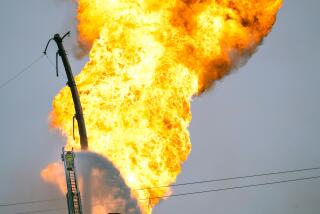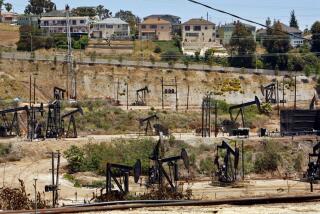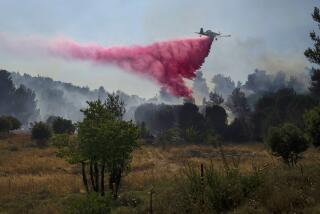COLUMN ONE : Hotshots in Kuwait’s Fiery Hell : 3 Texas crews battle some of the 600 or so oil well blazes ignited by retreating Iraqi troops. But they still don’t have the water and equipment they need to do their job.
GREATER BURGAN OIL FIELD, Kuwait — It is a busy day in hell.
On all sides, oil wells burn like giant blowtorches. Jets of yellow flame send black smoke and intense heat swirling into a murky, midnight gloom.
Near some wells, the oil-soaked desert is aflame, blazing and bubbling like a primeval lava field. Other wells are gushers, shooting oil into deadly, still lakes that form black mirrors to the flames.
The sound is of jumbo jets revving for takeoff. An acrid stench burns the nose. Tiny droplets of oil quickly cover clothes, glasses and windshields.
There is no sun. Instead, when the gloom parts, a strange reddish orb stares down like a bloodshot eye over a blackened landscape littered with tanks and trucks, cluster bombs and mines.
And down in the drilling yards, the crews who have come to extinguish and cap 600 or so fires and gushers, set off by retreating Iraqi troops, are working in moods as black as the choking pall of smoke.
“Can’t put out any damn fires until we get water and equipment,” fumes Boots Hanson, 64, as angry as the tattooed purple python crawling up his enormous right bicep.
Hanson is the top half of Boots & Coots, one of three Texas-based firefighting teams brought here as the only hope of controlling an environmental catastrophe that a U.N. official recently compared to the Soviet nuclear disaster at Chernobyl.
Rough-hewn and hard-talking, they are the hotshots, the glory boys, famed for fighting oil fires from Alaska to Zaire. Once mere roustabouts and roughnecks, they charge $1,000 each per day to battle the mother of all infernos.
No one has ever fought more than five oil fires at a time. That was in Libya, and it took eight months. But Hanson, who cusses with great skill, questions a reporter’s lineage when asked if they can fight so many blazes.
“There’s nothing out here we can’t handle,” he says acidly. “Gawdamn! Nothing! Hell, no! There’s just a lot of ‘em. Damn!”
Nearby, Ace Barnes, 62, half his face badly scarred by fire, only laughs. It’ll take a year, he says. Or two. Maybe more.
“Your guess is as good as mine, son,” Barnes adds in a thick drawl. “Some will go easy. Some will go long and hard.”
The work is already hard. Last week, Saudi border officials strip-searched a 52-truck convoy of oil equipment, letting only six trucks cross into Kuwait per day. Equipment is now arriving on U.S. Air Force C-5A Galaxies or being shipped by sea.
But no one can douse a fire without water. Engineers are struggling to rebuild 6-inch oil pipelines that stretch 40 miles to the Persian Gulf so they can be used to pump water uphill instead of carry oil downhill. It may take three weeks.
Last Saturday, Hanson’s crew tried anyway. Using a “Tush Hog,” a 60-foot horizontal crane powered by a bulldozer, they lowered a black steel chimney over a blazing oil head.
The plan was to starve the fire of oxygen, then pump in thousands of gallons of water from four fire trucks. After two tries, the fire burned less intensely. But it did not go out.
Hanson says he may try nitrogen next. Usually, firefighters use a 55-gallon drum packed with dynamite to blow out fires. But they need vast amounts of water--up to 15,000 gallons a minute--to keep the ground and equipment cool.
So while waiting for water, crews have plugged a dozen gushers. They jab a “stinger,” a tapered pipe at the end of the crane, into the wellhead and force heavy drilling mud and cement down the shaft to plug the gusher.
About five fires have gone out on their own as underground water mixed with the oil. But oil men say the “squirters” are more dangerous than the fires, which tend to burn off deadly gases such as hydrogen sulfide.
“If you smell it, it’s rotten eggs,” explains David Haines, 29. “If you don’t smell it, you’ve waited too long. The first thing it does is kill your sense of smell. Then it shuts down your respiratory system and kills you.”
Haines, a well plugger for Halliburton Services, is surrounded by towering flames six miles down a smoke-filled road, flanked by oil-soaked fields of crackling red and yellow fire.
Nearby, Ray Wadley wades through the black ooze and supervises as masses of drilling mud and cement are pumped down a 4,400-foot-deep gusher called Magwa 4.
“Nobody’s ever seen anything like this,” he says, shaking his head under a hard hat from Iran, etched with peacocks and leafy vines. “And no one ever will again.”
Wadley, 66, should know. He’s called the Grand Old Man of Kuwait’s oil fields. He retired last year after spending 33 years in the Middle East, drilling more than 100 wells in Kuwait alone.
“His whole life is digging holes in the ground,” says his son, Bob, 42, another oil man. “This is home to him. And someone destroyed his home and killed 600 of his babies.”
Ray Wadley was one of the first oil men to return to Kuwait. He spent two weeks surveying the four main fields down south. Of 350 wells he inspected, only two were undamaged. Another 250 were destroyed or damaged in three fields up north.
“It took 50 years to get all these wells in production,” Wadley says. “It only took the Iraqis one day to blow them all. Ain’t that something?”
It is indeed. The damaged wells are burning or gushing an estimated 6 million barrels of oil a day, worth more than $100 million, and three times Kuwait’s prewar daily production.
Experts say restoring its prewar exports may take five years or longer. But no one knows how the vast underground reservoirs are changing as water and sand are sucked in, or whether Kuwait will ever regain full production from its 92-billion-barrel proven reserves.
“You’re not going to salvage most of these wells,” Wadley says. “The damage is so bad, it’s less expensive to drill new wells than try to replace these.”
But that’s in the future. So are camps for some 11,000 workers--including 1,000 expatriate oil men--who will be hired to begin rebuilding the fields in six months.
For now, about 140 men, including about two dozen firefighters, have arrived. They are easy to spot: Boots & Coots crews sport white overalls, Wild Well Control crews wear yellow and H. R. (Red) Adair’s men wear red. A fourth team, Safety Boss of Canada, has yet to show.
Adair, now 76 and still in Houston, was the pioneer who started firefighting in Oklahoma in 1938. John Wayne portrayed him in the movies, and envious rivals say he won’t even discuss taking a job until he gets $1 million in advance.
The rivalry is no secret. Hanson worked for Adair for 26 years. “He fired Coots Matthews and me Dec. 6, 1977,” he says. “Insubordination, I think. So we formed our own company. And every Dec. 6, we send him a thank-you card.”
One of Adair’s crews worked a giant red rig on a well that spewed a geyser of flame and black smoke barely a block from the hospital in Ahmadi, the Kuwait Oil Company headquarters town near Kuwait city.
A yellow Caterpillar bulldozer, with a corrugated tin shed built over the top to protect the driver, pulled a crane with a black triangular hoe on the end. For over an hour, they poked and stabbed at the blazing wellhead, trying to rake melted valves and fences away from the hole.
“The straighter the fire burns, the cleaner it is,” explains Bert Ballard, 30, an Adair firefighter. “That’s safer, and makes our job easier later.”
The U.S. Army is helping, exploring for unexploded mines and ordnance in the hundreds of abandoned Iraqi bunkers dug into the oil fields. One field had a dozen armored personnel carriers, tracked howitzers and tanks dug into sandy revetments.
“This is where we do our shopping,” says oil worker Dennis (Pigpen) Polzien, 35. For an hour, he scavenged for tools and souvenirs in oil-blackened, sandbagged bunkers filled with cast-off Iraqi uniforms, mattresses and ammunition.
Dozens of wires led to one bunker, and Polzien shouts with delight when he finds two British-made “Exploder Dynamo Condenser” crank boxes, used to fire the C-4 explosive charges that blew nearby wells.
“This was the mad bomber!” he says happily. Then he looked around. “What a friggin’ mess.”
Each well burns differently, depending on the pressure and the damage. Some shoot flames 100 feet straight up. Others blast billows of fire, evidence that the “Christmas tree” wellhead is destroyed and oil is spraying wildly from the ground.
“We’ll have to dig 20 feet out, cut out all the damaged pipe, then rebuild the wellhead,” says Adair firefighter Brian Krause, 35. “That’s the most difficult kind.”
The teams tend to work in groups of three. One drives the bulldozer, facing another man who stands on a grate mounted on the ‘dozer’s blade. He directs the driver by peering through windows cut in a huge corrugated tin shield.
The third man works at the wellhead, protected from the intense heat by the water spraying overhead.
“When I start smelling my mustache burn, I know I’m too close,” says Krause. “That’s happened a lot.”
Each team is given a separate field of about 40 wells. Bulldozers will dig huge plastic-lined lagoons--10 feet deep, 150 feet on each side--for water.
Crews vary, but most firefighters will work a month, then go home for a month. For this job, each will get regular chest X-rays. What they will show is unclear, since most firefighters seem to smoke incessantly in the eerie gloom.
Like most of them, Ace Barnes doesn’t wear a mask to cut the fumes. It would only interfere with the Marlboros he lights end to end.
“Some ecologists say it’s like smoking five packs of cigarettes a day,” Barnes says. “I smoke three packs anyway.”
Over in another field, Joe Bowden’s Wild Well Control crew works in a drilling yard last used by an Iraqi tank company. Four of the Soviet-made T-55s are abandoned, with unexploded cluster bombs and shells scattered in the sand. It’s so dark that two nearby oil fires provide most of the light.
Still, Bowden, 58, who started roughnecking when he was 13, says the fires don’t bother him.
“People misunderstand,” he says. “The fires aren’t the problem. It’s the wells that aren’t on fire that cause the worst pollution.”
An oil well fire has “no surprises,” Bowden says. “We let it burn as long as we can. When it’s out, any spark can set it off. That’s the most dangerous.
“Many of these fires, we’ll put ‘em out, then go up and take measurements and check the damage,” he adds. “Then we’ll reignite ‘em until we’re ready to cap ‘em.”
Bowden’s five men work on their rig, “Big Mama,” building rakes and “stingers” and welding a giant makeshift blowtorch for the bitter battles to come.
“A person sitting in front of his TV cannot visualize this,” he says. “Look at us! Dark skies all around, and every direction you look, there’s another well on fire or gushing.”
“Everybody says how long, or what’s the effect on the environment?” he adds. “Who the hell knows? The world’s never seen this before. Hell, no one even thought of this before.”
More to Read
Sign up for Essential California
The most important California stories and recommendations in your inbox every morning.
You may occasionally receive promotional content from the Los Angeles Times.











